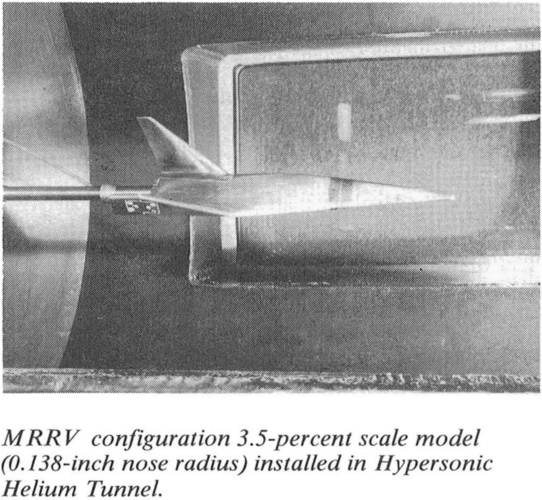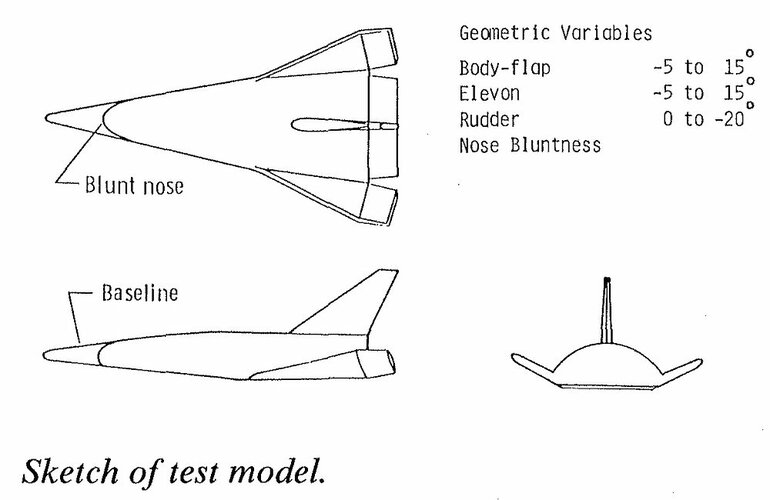You are using an out of date browser. It may not display this or other websites correctly.
You should upgrade or use an alternative browser.
You should upgrade or use an alternative browser.
Shuttle-launched MRRV (Maneuvering Re-entry Research Vehicle)
- Thread starter Matej
- Start date
- Joined
- 31 December 2006
- Messages
- 801
- Reaction score
- 362
It's the Maneuvering Re-entry Research Vehicle. It was intended to be launched from the Shuttle to explore the hypersonic speed range between NHFRF ("X-24C") and orbital speed. It was to be used in several types of flight patterns, including low angle-of-attack re-entry, high cross-range, etc.
Details in AIAA 1977-1165.
George
Details in AIAA 1977-1165.
George
Matej
Multiuniversal creator
Thanks to you George and also to flateric (you know why  ).
).
Abstract:
A concept for highly maneuverable research entry vehicles is presented. The vehicles could be transported into orbit within the payload bay of the Space Shuttle. Such research vehicles would bridge the technology gap between the National Hypersonic Flight Research Facility, advanced air-breathing aricraft and the Space Shuttle. Suggestions are given for evaluating the research utility of payload vehicles which have the potential of high versatility to investigate the technologies required for rapid recall from orbit and return to a precision Earth landing within minimum time. The ability to utilize aerodynamic means for performing a wide spectrum of operational modes is identified along with the relation to previous investigation. Experiments which are applicable to advanced high performance lifting entry and which could be incorporaded in this program are discussed.
Abstract:
A concept for highly maneuverable research entry vehicles is presented. The vehicles could be transported into orbit within the payload bay of the Space Shuttle. Such research vehicles would bridge the technology gap between the National Hypersonic Flight Research Facility, advanced air-breathing aricraft and the Space Shuttle. Suggestions are given for evaluating the research utility of payload vehicles which have the potential of high versatility to investigate the technologies required for rapid recall from orbit and return to a precision Earth landing within minimum time. The ability to utilize aerodynamic means for performing a wide spectrum of operational modes is identified along with the relation to previous investigation. Experiments which are applicable to advanced high performance lifting entry and which could be incorporaded in this program are discussed.
- Joined
- 2 May 2007
- Messages
- 481
- Reaction score
- 1,912
Experimental Investigation of Maneuvering Reentry Research Vehicle at Mach 6 and 20.3

from 'Langley Aeronautics and Space Test Highlights 1984'
A maneuvering reentry research vehicle (MRRV) has been proposed by the U. S. Air Force as a test bed for experiments in the hypersonic flight regime. The MRRV was conceived as a vehicle that flies in the hypersonic regime along trajectories that the Space Shuttle cannot fly because of aerodynamic and heating limitations. The MRRV would serve as a convenient means of testing thermal protection systems, structural concepts, guidance and control systems, and other future technologies, as well as alternative flight paths for advanced reentry spacecraft.
As part of the study of the MRRV, force and moment tests were conducted on a 3.5-percent scale model of the vehicle in the 20-Inch Mach 6 Tunnel and the Hypersonic Helium Tunnel. The tests were conducted at a nominal Mach number of 6 and Reynolds number of 3.6 x 10^6 per foot for an angle-of-attack range from -4° to 20° and a nominal Mach number of 20.3 and Reynolds number of 6.8 x 10^6 per foot for an angle-of-attack range from 0° to 25°. Lateral-directional data were obtained at sideslip angles of 0° to -4°.
The investigation determined rudder effectiveness, sideslip derivatives, and the effects of body flap and elevon deflection on pitch, as well as the effects of elevon deflections on roll. In addition, two noses of 42 different radii (0.138 and 0.302 in.) were tested to determine bluntness effects.
The baseline vehicle (0. 138-in. nose radius) has longitudinal and lateral-directional stability at angles of attack from 12° (maximum lift-to-drag ratio) to 25°. The blunt-nose vehicle (0.302-in. nose radius) has longitudinal and lateral stability at angles of attack from 15° (maximum lift-to-drag ratio) to 25° and directional stability for angles of attack greater than 15°.
(Gregory J. Brauckmann, 2483)As part of the study of the MRRV, force and moment tests were conducted on a 3.5-percent scale model of the vehicle in the 20-Inch Mach 6 Tunnel and the Hypersonic Helium Tunnel. The tests were conducted at a nominal Mach number of 6 and Reynolds number of 3.6 x 10^6 per foot for an angle-of-attack range from -4° to 20° and a nominal Mach number of 20.3 and Reynolds number of 6.8 x 10^6 per foot for an angle-of-attack range from 0° to 25°. Lateral-directional data were obtained at sideslip angles of 0° to -4°.
The investigation determined rudder effectiveness, sideslip derivatives, and the effects of body flap and elevon deflection on pitch, as well as the effects of elevon deflections on roll. In addition, two noses of 42 different radii (0.138 and 0.302 in.) were tested to determine bluntness effects.
The baseline vehicle (0. 138-in. nose radius) has longitudinal and lateral-directional stability at angles of attack from 12° (maximum lift-to-drag ratio) to 25°. The blunt-nose vehicle (0.302-in. nose radius) has longitudinal and lateral stability at angles of attack from 15° (maximum lift-to-drag ratio) to 25° and directional stability for angles of attack greater than 15°.

from 'Langley Aeronautics and Space Test Highlights 1984'
Last edited:
- Joined
- 2 May 2007
- Messages
- 481
- Reaction score
- 1,912
..and in 1985:
Experimental Investigation of Maneuvering Reentry Research Vehicle at Subsonic Mach Numbers

Experimental Investigation of Maneuvering Reentry Research Vehicle at Subsonic Mach Numbers
As part of the development of the MRRV, force and moment tests were conducted on a 3.5-percent scale model of the vehicle in the Langley Diffuser Flow Apparatus, which is part of the 8-ft TPT complex. The tests were conducted at nominal Mach numbers of 0.4, 0.6, 0.8, and 0.9 in air for an angle-of-attack range from _2° to 15°. Lateral-directional data were obtained at sideslip angles of 0° and -3.3°.
The test schedule included investigations of the effects of body flap, elevon, and speed brake deflection on pitch, as well as the effects of elevon deflections on roll, rudder effectiveness, and sideslip derivatives. In addition, three noses of different radii were tested to determine bluntness effects. Preliminary analysis of the data showed that although the basic configuration is longitudinally unstable, trim points
exist for several combinations of control surface deflections for the range of Mach numbers tested.
(Gregory J. Brauckmann, 2483)The test schedule included investigations of the effects of body flap, elevon, and speed brake deflection on pitch, as well as the effects of elevon deflections on roll, rudder effectiveness, and sideslip derivatives. In addition, three noses of different radii were tested to determine bluntness effects. Preliminary analysis of the data showed that although the basic configuration is longitudinally unstable, trim points
exist for several combinations of control surface deflections for the range of Mach numbers tested.

Similar threads
-
-
-
General Dynamics PLAME re-entry vehicle concept
- Started by Retrofit
- Replies: 1
-
-
Teledyne Ryan disk-shaped vehicle with annular nozzle
- Started by Stargazer
- Replies: 1

